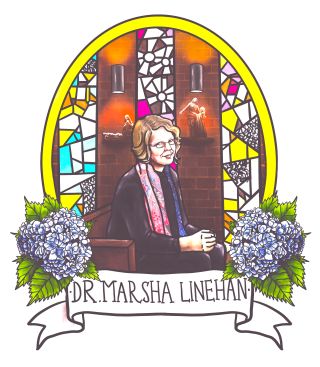Therapy
How Marsha Linehan Created DBT to Help Us
Dialectical Behavior Therapy: Solutions for emotionally sensitive people.
Updated June 27, 2024 Reviewed by Monica Vilhauer
Dialectical behavior therapy can be transformative for anyone dealing with intense emotions. Extensive research has proven its effectiveness for all kinds of mental health issues.
DBT was originally developed to treat suicide and self-harm. For people with persistent suicidal ideation, DBT can be lifesaving.
Many people on the DBT therapy journey have struggled with suicidal thoughts their whole lives. Then suddenly, one day, something bad happens and they listen for their suicidal thoughts—and realize those thoughts have been replaced with skills from DBT.

DBT Was Created by Dr. Marsha Linehan
Dr. Marsha Linehan is the creator of DBT. As a young woman, she was in emotional agony. At eighteen, Linehan was put in a secure psychiatric hospital to keep her from harming herself. She lived there for two years. In her memoir, Building a Life Worth Living, she describes how her faith and a sense of purpose drove her recovery.
After being released from the psychiatric facility, Linehan set out to create the treatment she needed. She got her PhD in research psychology as part of her lifelong journey to help people grow out of a tormented existence into a meaningful life.
In 1993, after years of research, trial and error, and creativity, Linehan published Cognitive-Behavioral Treatment for Borderline Personality Disorder, introducing the world to dialectical behavior therapy.
To create DBT, Linehan drew from cognitive behavioral therapy, dialectical philosophy, and Buddhist psychology.
Cognitive Behavioral Therapy
Linehan started her research by treating suicidal patients with cognitive behavioral therapy (CBT). The basic idea of CBT is to change your thinking and behavior to change your emotions.
As you grow up, you develop core beliefs about yourself. These core beliefs can be intensely painful, like I am worthless, or I am unlovable, or something is wrong with me. They drive our brains to have automatic thoughts in response to our environment.
For example, suppose you are starting a new job, and the people aren’t friendly. If you have a core belief about no one liking you, you might have the automatic thought of everyone here hates me. However, if you believe people tend to like you, your automatic thought might be something like—these people don’t seem friendly. I wonder what’s going on?
So much agony grows out of negative core beliefs. In cognitive behavioral therapy, the therapist works with you to challenge those core beliefs. This transforms the kind of automatic thoughts you have, significantly reducing your suffering.
In her research, Linehan found CBT’s focus on change was too invalidating for her suicidal clients. They felt unseen. Many emotionally sensitive people are so used to having their experiences invalidated that the emphasis on challenging core beliefs can feel like another round of “You’re overreacting.” The logic-oriented strategies of CBT were not the cure for this population.
Acceptance Vs. Change
Linehan then tried therapies focused on acceptance instead of change. These approaches support and validate the client’s painful life experiences in a way CBT does not.
My personal mental health journey started with psychodynamic therapy, focused on acceptance. Some excellent therapists helped me understand why I was so emotional and suicidal. My pain was validated. They helped me understand I had good reasons for being so sensitive.

I knew how I got here, but I didn’t know how to do anything differently. I felt doomed by my past. How would I ever be able to change anything? I wanted someone to show me how. I wanted a tool kit—with tools I could apply to every situation. It turns out this experience is common for many people who end up in DBT.
According to Linehan’s research, therapy that focuses on acceptance and validation leaves people who have suicidal urges feeling stuck and frustrated.
With this knowledge, Linehan determined that DBT needed to include profound acceptance as well as targeted strategies for change. People like me (and maybe you?) need to feel deeply accepted and understood as we are. We also need tools and guidance for changing our lives.
Dialectical Philosophy
Dialectical thinking recognizes that two opposing truths can be true at the same time. It’s the opposite of black-and-white thinking or all-or-nothing thinking. I think of it as brain yoga because it makes your brain more flexible.
Balancing a stance of acceptance while pushing for change is very dialectical. When a colleague pointed out the dialectical nature of the treatment Linehan was developing, she responded, “What are Dialectics?”
And voilà! After Linehan visited the philosophy department at the University of Washington, dialectical philosophy became a central part of the treatment. Linehan decided that a dialectical perspective must be incorporated into every aspect of the therapy.

Buddhist Psychology
Buddhist psychology is based on the teachings of the Buddha. In the fifth century BCE, a prince named Siddhartha Gautama set out to understand the causes of human suffering and how to overcome them. How do we resolve the suffering caused by death, aging, and disease? Loss? And longing?

Siddhartha’s search for these answers led him to many teachers. After years of searching, learning, and practicing the teachings of many gurus, he sat under a bodhi tree, faced numerous challenges, and . . . ultimately, he achieved enlightenment. He was free from the endless cycles of craving and suffering that plague all humans. He became a Buddha (enlightened one) through mindfulness, nonattachment, and accepting the impermanence of all things.
I think of the Buddha as the first great psychologist. His teachings are highly Effective for reducing suffering in this life. Mindfulness is foundational to his teachings. These mindfulness strategies have become popular in Western psychology because they are so effective. The first unit of DBT is devoted to powerful Mindfulness practices that can create significant shifts in the way we live our lives.
References
This is an excerpt from Diana Partington’s book "DBT for Life: Skills to Transform the Way You Live."




